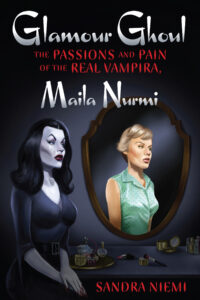
Sandra Niemi
Feral House (January 12, 2021)
Reviewed by Nancy Kilpatrick
It is normal for biographers to be fascinated by their subjects. Frequently, they strive to present an unbiased view of the life of a person famous for any number of reasons. Glamour Ghoul is not unbiased. This twelve-years-in-the-making book is lovingly written by Sandra Niemi, Maila Niemi’s niece. She states right from the get-go that she idolized her aunt. Many readers will have come from a family where somewhere amidst the extension is a round person unable to fit into the square hole of family ethos. Some readers may even be that oddball.
The next-of-kin at Maila Niemi’s demise, Sandra Niemi fought her way into the decease’s last apartment to discover a treasure trove of previously unknown diaries, notes, letters never sent, photographs, all from the person rather than the public figure.
Unfamiliarity with the name Maila Niemi (who changed her last name to Nurmi) is understandable. She was and is known by the name Vampira, whose claim to fame occurred in the 1950s and yet continues to this day.
Back in the 1950s television was in its infancy, and regional. If you lived in Philadelphia, it was Roland (John Zacherle) hosting Shock Theater from 1957 to 1958 before he was scooped up by New York in 1959 and added a ‘y’ to his last name. In Chicago, you might have seen Marvin from 1957 to 1959. Mad scientist Morgus the Magnificent hosted in New Orleans and Selwyn in Minneapolis, both from 1959 onward. These creepy hosts spawned many progeny up to the present, all late night dark fun surrounding segments of horror and sci fi B-movies.
But at the head of the pack from 1954-55, Los Angeles had Vampira. The Vampira Show featured Maila Nurmi as the originator of the ghoulish TV horror-film host/ess, and also the first female in that position.
Maila Elizabeth Niemi/Nurmi left home as soon as she could for Hollywood and there changed her last name. She rewrote her history as well–normal studio hype back then–claiming to be born in Finland but really hailing from Massachusetts to Ohio and later Oregon. She was ‘discovered’ during a costume party and contracted by a budding LA TV station and–possibly in the smartest move of her life–kept the rights to her character. Vampira was loosely based on a cartoon character Maila loved, the female vampire-wife in Charles/Chas Addams cartoons of The Addams Family, which he published beginning in the 1930s in The New Yorker. Vampira, black-hair, black-clad, sporting dagger fingernails, a wasp-waist, and a dead-eyed gaze became a dream and/or nightmare for the Hollywood crowd. She, along with Theda Bara, is considered a precursor of modern Goth.
Few clips from her show have survived, some public, others locked away with private collectors. She appeared on Broadway, worked as a model, and landed a number of minor roles in films and on stage. A skit on The George Gobel Show–the top TV show of the day–was followed by a gig with Liberace in Las Vegas on his ill-fated Come As You Are show at The Rivera. All of the above happened in the 1950s and as she aged, it was downhill from there for Maila, the person and the actress.
But despite career failures, she is iconicized for her brief appearance in schlock movie-maker Ed Wood’s bizarre film Plan 9 From Outer Space. Performing mute-by-choice during those 15 minutes led Vampira to world-wide fame. Despite a plethora of still images and whatever video clips remain of appearances and interviews, the phenomena known as Vampira best connects with modern audiences through Wood’s movie–which she was loath to make, but desperate for the work and the money.
Wild. Crazy. Impulsive. Creative. Beatnik. That and more is how Sandra Niemi describes her aunt. Maila Nurmi had affairs with men like Orson Wells, whose child she birthed and put up for adoption without telling him. Her closest friends were men. Many lovers were short-term, others longer-term, included Marlon Brando, James Dean, Anthony Perkins, and Elvis, to name a few. This impetuous woman surrounded herself with males, most of whom may or may not have been able or willing to help and guide her in decisions that might have led to a career save instead of a floundering. But she longed for a soul mate too, and ultimately resigned herself: it was impossible to find all of her wants and needs in the same loyal man.
Maila made a lot of poor decisions in her life, and one of the big reasons is her childhood. With a politicized evangelical father and a disappointed, alcoholic mother, there was no base of support for a dreamer. Including three marriages no male in her world took care of her, which she rued until the day she died. She ended up alone, a sad, withdrawn figure, suffering chronic disease and the fate of old age in a world that worships youth and beauty.
Glamour Ghoul is a well-written biography by a woman who loved and adored her father’s sister. Sandra Niemi had little direct contact with her aunt, and often visits were decades apart. Despite a look at Maila Nurmi’s life from birth to death and beyond that is saturated with understanding, acceptance and justifications, this book is worthwhile. The author’s adoration–and sympathy–doesn’t diminish the story of the real woman. We even get a glimpse of the dark comic book characters Maila loved as a child that formed the roots of Vampira–with whom she will be eternally identified.
Maila Nurmi lived on the edge of poverty and sometimes catapulted into that pit. Opinionated, she seemed unable to play the games required for fame and fortune. She had limited trust to offer and it was frequently betrayed. The character Vampira has been exploited quite a bit over the years, before and after her death, and she profited little if at all. Her autobiography wasn’t finished. Her Vampira vs. Elvira lawsuit was discontinued for lack of funds. Even Disney admits their character Maleficent is modelled on Vampira, but there’s no mention of a royalty.
All of Maila’s major loves are dead, and she had few girlfriends. There won’t be any further information about Vampira until collectors release material they are hoarding. What we have in this book presents a very wide scope of a life and shines a spotlight on an era with few options and little support for independent women. Despite that, Maila Nurmi has left her mark. Thirteen years after Maila’s death, Vampira is more famous today–and with a wider audience–than she was in her creator’s lifetime. That, alone, is a rarity. This biography lets us peek into another time and place, when Hollywood big-wigs sharpened stakes to destroy actresses with no backup. And yet going on seventy years after her creation, Vampira lives on as an extraordinary and fascinating creation. Hopefully that gave Maila some peace at the end of her life.
- Book Review: UNDER A RAVEN’S WING - June 25, 2021
- Book Review: GLAMOUR GHOUL - March 7, 2021
- Book Review: THE RESIDENCE - August 27, 2020



I placed an order for this biography and thanks to Nancy Kilpatrick I have an idea of what I am still waiting for. After reading this book review I feel more aware of what side of the story I’m going to get. This just leaves Me all that more anxious to read about the person behind the icon.